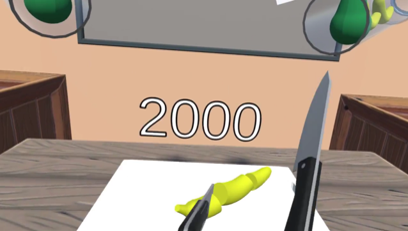Prompt: How can we innovate on the presentation of a note highway in VR?
Prototype Goals
- The team wanted to experiment with the presentation of a note highway in VR
- Exploit the immersive, diegetic nature of VR environments by placing players with a less abstract, more physically-present location
Details
Platform: Oculus Rift S
Players: 1
Controllers: Oculus Touch
Description
In this game, players are placed in a VR kitchen where they must chop and push ingredients that arrive to the beat of music.
Instructions
Ingredients will fall to the chopping board to the beat of the music. Using a chopping movement, chop each ingredient an appropriate amount of times, then push the chopped ingredients into bins by holding down the trigger and swiping the ingredient.
There are three types of ingredients: avocados, which require 1 chop; bananas, which require 2 chops; and mushrooms, which require 3 chops to be successfully chopped. Players earn 10 points for pushing an unchopped ingredient into a bin, or 100 points for pushing a chopped ingredient into a bin.
Mechanics
Chop
Move the controller in an up-and-down chopping motion to chop the ingredients. The knife must fully leave an ingredient before it can be chopped again. Chopping may only be done while the Oculus Touch’s trigger is not pressed (indicated by a silver, normal-looking knife).
Push
Players must hold the Oculus Touch trigger down to turn the knife red. Once it is red, the knife can no longer chop; it can only be used to push ingredients. Players must swipe the ingredients to the left or right so they land in the bins to score points.
Ingredients
Different ingredients require a different number of chops. Avocados (green) require one chop, bananas (yellow) require two, and mushrooms (red) require three. All ingredients must be pushed into bins after being chopped the correct number of times.
Points
Players earn 10 points for pushing an unchopped ingredient into a bin, or 100 points for pushing a chopped ingredient into a bin.
Iteration Thoughts
Music
- Music tempo should correspond with time taken for actions. Don’t expect the player to have superhuman reflexes to play the game.
- Our playtests showed that it would be more effectful if the fruits landed on the beat, not spawned. Because gravity is a constant, any changes to positioning or height affects the timing of when items land. Since we wanted to keep “real” physics in play, this pigeonholed our ability to move spawn locations and the overall design of the beatmap.
- Further iteration into the music could make the song instruments follow the action that is taking place. For example, the accordion ornamentation could better match the number of cuts that are required at a given time. This is assuming a song based beatmap is used.
Visuals
- Since we didn’t want the items to come directly in front of you like most note highways, we tried to place two tubes on either side of you. Part of the tube was clear, so that the player could see some of the items, while other parts were dark. However, we learned in our first iteration that players couldn’t really see the tubes. Our second iteration, we placed the tubes at a 45 degree angle, with a board in front of you. The board would remind you what objects needed to be chopped once, twice, or three times.
- We also needed to make sure the player received feedback as to whether they had chopped something correctly. Each item had to have different models for their chopped state. Further iterations could allow us to add models in between– if you chopped an item that needs three chops once, then you would see it starting to be chopped, and so on, until the third state.
Design
- Good principles for VR design can sometimes clash with rhythm game design principles. We made the notes in our note highway physics-responsive because players in VR respond well to objects behaving as they would in real life; however, this adds an element of impreciseness to the objects that rhythm games often don’t permit.
- In VR note highway games like Beat Saber, Audica, etc., the notes move linearly towards the player and don’t respond to outside forces.
- In the end, we solved the problem by simulating physics for certain elements of the game, such as when the ingredients fall to the chopping board, or when players swipe the ingredients into the bins.
- Rather than force players to chop things on the beat, we chose to have the ingredients land on the chopping board to the beat instead.
Lessons Learned
- Real physics are very satisfying, but add complications and are not 100% conducive to accuracy when dealing with beatmap integrations.
- The realistic setting and interaction make the rhythmic action easy to understand, even to VR novices and non-gamers.
- Our explorations in innovating on the “note highway” in VR allowed us to unravel havoc on the certain key elements that the traditional note highway represents. Tradition note highways gives the game designers very complete control over the world, while allowing players a very limited area of interaction. Allowing physics (and the freedom it gives to cues) into the picture within VR relinquishes that control, which is why such a free environment for note highway/rhythm games probably isn’t the route to go.
